Low-code : How to Build a Business Application without coding ?
Blog
·
01/08/2025
·
What if digitizing your business processes no longer required a team of developers?
Thanks to low-code platforms like Elix, that vision is now a reality.
This quiet yet powerful revolution is transforming how organizations approach software development, making it faster, more accessible, and cost-effective.
In this article, we’ll answer all your key questions about building applications without code, and show you how low-code can become a game-changer for your business.
What exactly is a Low-Code Platform?
A low-code platform enables you to build applications through a simple graphical interface using pre-built components such as forms, fields, workflows, tables, and more. Instead of writing code line by line, you visually assemble functional blocks. This approach dramatically reduces development time and makes the process much easier to use.
Low-code ≠ no developers, but less coding = greater agility and faster project delivery.
What are the differences between No-Code and Low-Code?
| Low-code | No-code |
For whom? | Advanced users, IT teams, project managers, developers | Business users without technical skills (e.g., Marketing Managers) |
Customization | Very high (allows adding custom code) | Limited to what the platform offers through visual interface |
App complexity | Complex applications, multiple integrations, advanced workflows | Simple apps, forms, basic automations |
Deployment | Often integrated with existing IT infrastructure, supports on-premise or cloud deployment | Mainly cloud-based, sometimes with customization limitations |
Why is Low-Code so appealing to SMEs?
In today’s environment of tight deadlines, limited budgets, and stretched human resources, low-code stands out as a powerful accelerator and a practical solution to the challenges of digital transformation.
Here’s why it’s winning over so many companies:
1. Accelerated Development
Low-code enables application creation up to 10 times faster than traditional methods. By using pre-built blocks, automated data models, and drag-and-drop interfaces, projects can move from concept to prototype in just days, or even hours.
According to Gartner, 80% of critical applications worldwide will be built on enterprise low-code platforms by 2029, a significant rise from the estimated 15% in 2024.
2. Empowered Teams
Low-code lets business users build the tools they need themselves, without waiting months for IT project approvals and development. This autonomy frees up IT teams to focus on more complex or strategic tasks.
3. Cost Savings
With a low-code platform, businesses can :
✅Reduce expenses on technical outsourcing,
✅Lower costs associated with hiring highly technical or senior profiles,
✅Optimize the total cost of ownership (TCO) of internal applications.
➡️The return on investment (ROI) from a well-utilized low-code platform can be seen within the first few months (Less development = fewer resources used = significant savings)
4. Better Business-IT Collaboration
Low-code bridges the gap between business and technical teams by using a shared language: the visual interface. No more misunderstandings between “what we want” and “what’s feasible”!
✅ Clearer specifications
✅ Fewer back-and-forths
✅ Stronger synergy between business units, IT, and digital transformation teams
➡️Low-code doesn’t isolate business teams, it reconnects them with IT, streamlining collaboration.
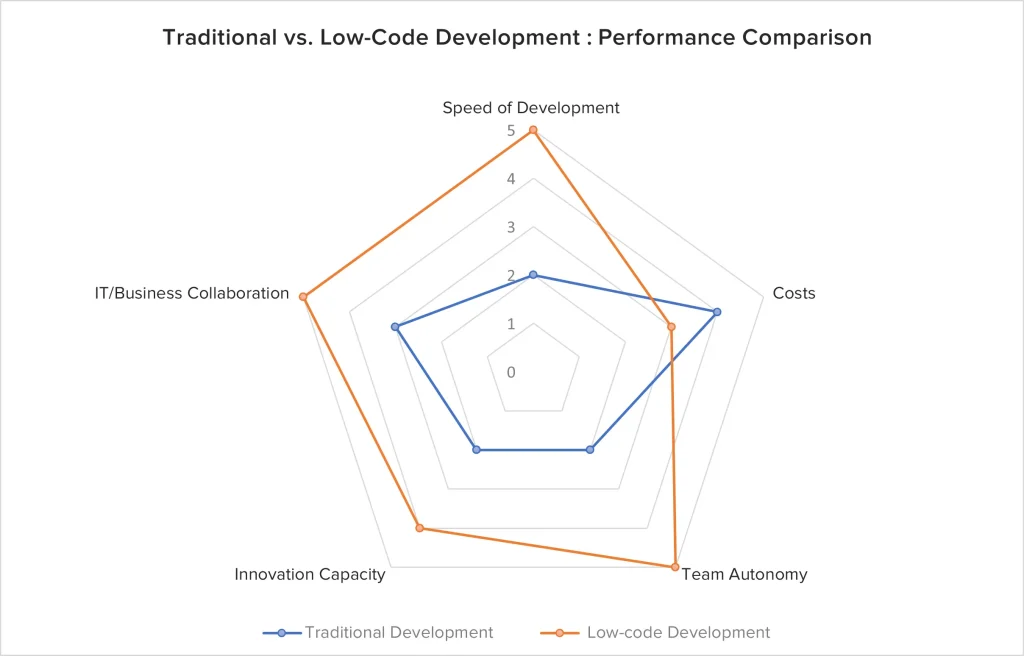
Why Choose Elix as your Low-Code Business Management Platform?
1. What is Elix’s Low-Code Builder?
Technology should adapt to business processes, not the other way around. That’s the core purpose of our Low-Code Builder : to empower you to create custom applications, workflows, and dashboards without writing a single line of code.
Elix’s Low-Code Builder is an integrated module within the Elix suite, designed for companies and organizations seeking greater autonomy, speed, and agility.
Here’s an overview of its key features:
✅Object Generator: Create custom business objects (e.g., tasks, tickets, products, contacts, requests) using drag-and-drop interfaces to add attributes, validation rules, constraints, or state workflows.
✅Form Builder: Configure input fields with forms, conditional fields, validation rules, and more.
✅Workflow Manager: Design and customize workflows through an integrated BPMN interface (statuses, triggers, automatic actions, approval processes)—all configurable without coding.
✅Search & Filters: Easily filter and locate any information within your objects, tables, or processes.
✅API Generation: Automatically generate API endpoints based on defined objects, workflows, or projects for fast integration with other systems.
✅Graph Builder: Create custom charts (bar, line, pie charts, etc.) and assemble them into interactive dashboards with export options.
➡️In summary : With Elix’s Low-Code Builder, every team can digitize their processes, automate workflows, and build their own tailored business tools.
2. How to Create an Application with Elix?
With Elix, you can digitize a business process from start to finish in just 4 simple steps, no technical skills required.
Step 1 : Create a Business Object
Start by defining your main object, for example “Leave Request” or any other process/ object specific to your business.
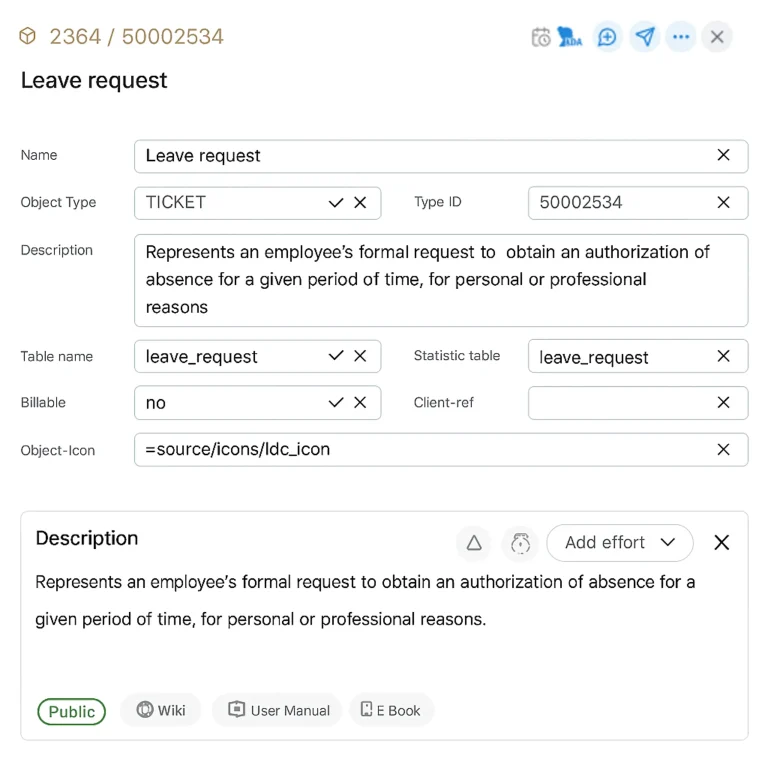
Step 2 : Design the Workflow
Using the integrated BPMN Editor, visually structure the different steps in the process :
- Submission by employee
- Approval by manager
- HR validation
- Automatic update of leave balance in the HR system
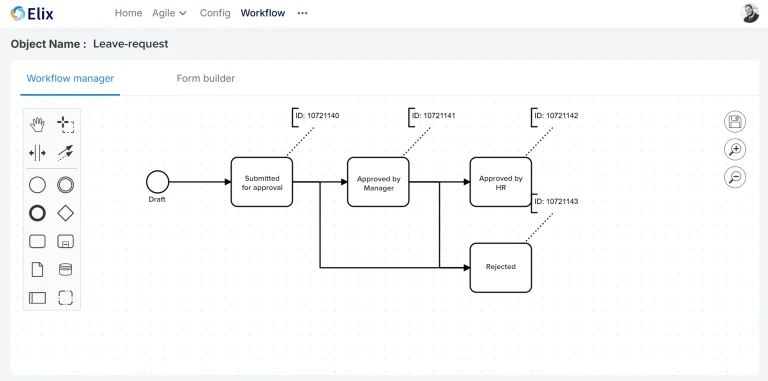
Step 3 : Configure Form Fields
Create a simple and user-friendly form for users with input fields. I this case (HR pocess), attributes might include: Employee name, leave type (annual, sick, unpaid, etc.), start and end dates, reason, and request status (draft, pending, to be approved, rejected).
You can add conditional fields and validation rules, for example: the start date cannot be earlier than today, or the number of days requested must not exceed the available leave balance
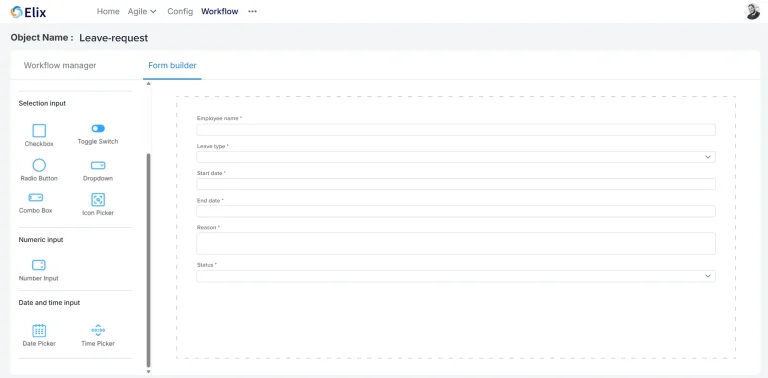
Step 4 : Generate Views
With just a few clicks, create :
- Lists filtered by status, employee, team, or period (example below)
- Charts showing leave by type, month, or department
- HR dashboards to monitor request volumes, approval rates, and remaining balances in real time
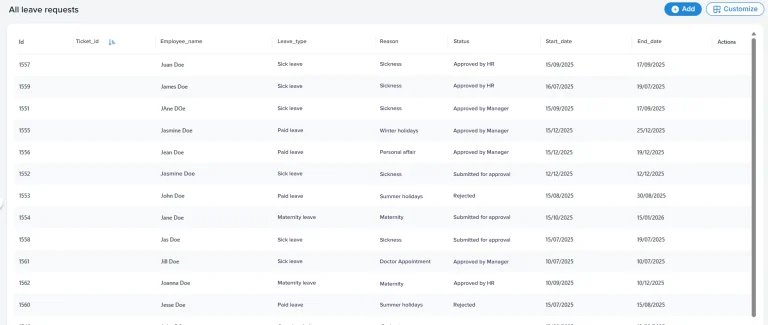
3. What Apps can you build with Elix’s Low-Code Builder?
Elix’s Low-Code Builder enables rapid modeling of a wide variety of business applications. Here are some concrete use cases by department:
HR : Leave management, recruitment tracking (onboarding process)
Finance & Accounting : Financing and procurement requests, budget tracking per department
Sales & Commercial : Mini-CRM for lead/client tracking, quote management
Customer Support : Support ticket tracking, response time management
Technical/ IT : Intervention tracking (maintenance, incidents), stock management, internal requests (equipment, etc.)
Building business applications without coding is no longer just an innovation dream, it’s a strategic necessity.
With a solution like Elix, you :
✅ Empower your teams
✅ Accelerate your digital transformation
✅ Take back control over your business tools
Content
The software development landscape is changing fast, and the latest catalyst is AI agents. While we've gotten used to AI-powered assistants that help with small, specific tasks, AI agents are different. Think of them as more than just a tool; they're like digital teammates that can work autonomously to achieve a goal.
Don’t delay your IT Projects any longer… Switch to Low code today!
